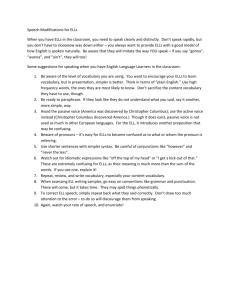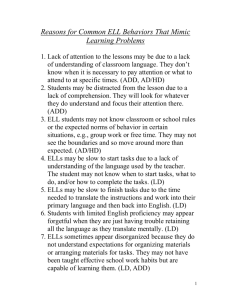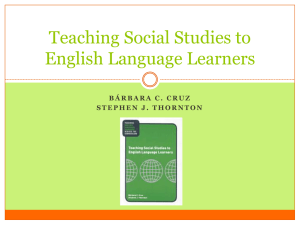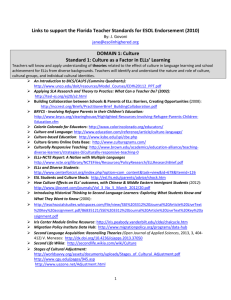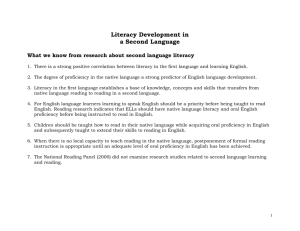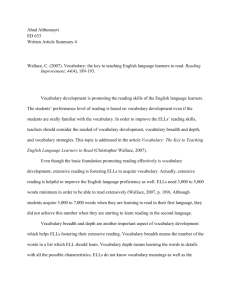April 21, 2010 - Literacy and Content Knowledge Development (SELL)
advertisement
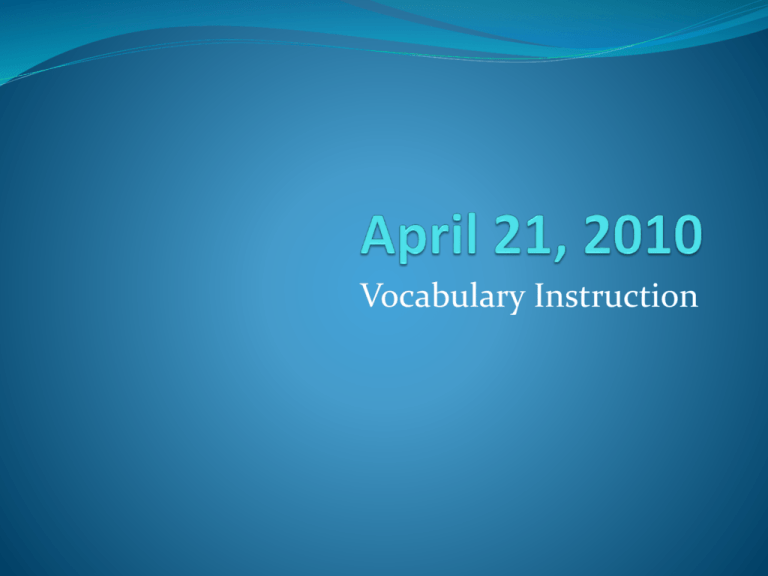
Vocabulary Instruction Source: The Center on Instruction is operated by RMC Research Corporation in partnership with the Florida Center for Reading Research at Florida State University; Instructional Research Group; the Texas Institute for Measurement, Evaluation, and Statistics at the University of Houston; and The Meadows Center for Preventing Educational Risk at The University of Texas at Austin. 2009 Funded by U.S. Department of Education Key areas of instruction: Vocabulary knowledge – an important predictor of reading fluency and reading comprehension for ELLs and non-ELLs (Grabe, 1991; McLaughlin, 1987) Academic language – critical for reading and understanding content Funded by U.S. Department of Education Schools must provide instruction that allows ELLs to acquire content-area knowledge while they are developing proficiency in English (NCLB, 2001). Funded by U.S. Department of Education Teach high utility words that appear often across content areas and are key to comprehension. Present definitions and examples of use in context. Provide multiple exposures to meaningful information about the word (Stahl & Nagy, 2006). Use cognate knowledge (Dressler, 2000). Teach word analysis and other word-learning skills. Engage students in learning words through talking about, comparing, analyzing, and using target words. Funded by U.S. Department of Education Native English speakers often depend on background knowledge and inferential skills when reading text. ELLs seem to rely more on their vocabulary knowledge when reading the same texts. Funded by U.S. Department of Education ELLs’ reading comprehension can be improved with targeted vocabulary intervention (Carlo et al., 2004). Students may need long-term intervention for maximum impact and comprehension development (McLaughlin, August, & Snow, 2000). Funded by U.S. Department of Education • Key components of instruction for ELLs: • Developing increased flexibility of English-language use • Learning words (vocabulary) in context • Distinguishing between important and unimportant text details and events • Responding orally to texts in increasingly skillful ways • Participating in student conversations related to text (Anderson & Roit, 1998) Funded by U.S. Department of Education High frequency English words General purpose academic words Content-area vocabulary English-Spanish cognates (for Spanish-speaking ELLs) Words conveying key concepts High-utility words Relevant to content under study Words that are meaningful to students (Gersten, Baker, & Unok Marks, 1998; Stahl & Nagy, 2006) Funded by U.S. Department of Education Funded by U.S. Department of Education oConversational language oUsed daily to communicate with others oBasic Interpersonal Communicative Skills (BICS) (Cummins, 1979) oAcademic language oThe language of text and content areas oCognitive Academic Language Proficiency (CALP) (Cummins, 1979) Funded by U.S. Department of Education To participate fully in the classroom and learn new content, ELLs must be able to Use and understand academic language in its various forms, for a variety of purposes; Learn new words (vocabulary) in context; Determine the difference between relevant and less relevant text in a given passage and the necessity of a specific reading and/or language task; and Participate in student conversations related to text. Funded by U.S. Department of Education Students need Basic Interpersonal Communication Skills (BICS). However, good conversational skills may be accompanied by poor academic language skills. Therefore, students need to develop Cognitive Academic Language Proficiency (CALP) to deal with academic content (Cummins, 1994). Funded by U.S. Department of Education to understand teacher explanations, to discuss what is being learned, to read for different purposes, and to write about their learning. Funded by U.S. Department of Education Is difficult for non-native speakers and many native speakers who are struggling readers; Uses and requires comprehension of a variety of language forms for a variety of purposes; and Incorporates multiple language structures. Funded by U.S. Department of Education Vocabulary knowledge Breadth: knowing the meanings of many words, including multiple words for the same, or related, concepts Depth: knowing multiple meanings, both common and uncommon, for a given word Understanding complex sentence structures and syntax Recognizing written vocabulary as distinct from oral vocabulary Understanding the structure of argument, academic discourse, and expository texts Funded by U.S. Department of Education •Classroom and content vocabulary in academic texts differ from conversational vocabulary. •Academic vocabulary is critical to learning higher-level content and to performing well on achievement tests. •Academic language: explains, informs, justifies, compares, describes, classifies, proves, debates, persuades, evaluates. Funded by U.S. Department of Education Scripted books purposefully crafted to reinforce word meaning Games for partner practice using picture cards Games that give students incentives to listen for new words or previously taught words outside the vocabulary lesson Funded by U.S. Department of Education ELLs and Special Education Strategic vocabulary interventions may reduce Special Education referrals and placement. (August, Carlo, Dressler, & Snow, 2005) Funded by U.S. Department of Education Lower-Order Skills •Recalling facts •Identifying vocabulary •Creating definitions Higher-Order Skills •Using language to analyze, synthesize, and evaluate Funded by U.S. Department of Education Is the reading proficiency required to construct the meaning of content-area texts and literature encountered in school. Encompasses the kind of reading proficiencies typically assessed on state-level accountability measures, such as the ability to make inferences from text learn new vocabulary from context link ideas across texts identify and summarize the most important ideas or content within a text (Torgesen et al., 2007) Funded by U.S. Department of Education Cognitive Academic Language Learning Approach (CALLA) Collaborative Strategic Reading (CSR) Sheltered Instruction (SI) Funded by U.S. Department of Education Designed to increase ELLs’ achievement (Chamot & O’Malley, 1996) Integrates: content-area instruction, language development, explicit instruction in learning strategies: Valuing prior knowledge Learning important content and language skills Developing language awareness and critical literacy Using appropriate learning strategies Learning to work with others in social context Learning through hands-on, inquiry-based and cooperative skills Increasing motivation Self-assessing learning Funded by U.S. Department of Education •Combines reading comprehension strategy and cooperative learning. •Is effective in culturally and linguistically diverse classrooms with struggling readers, ELLs, students with learning disabilities, average, and high-achieving students. •Students work in small heterogeneous groups . Funded by U.S. Department of Education Cooperative groups use 4 reading strategies: Preview (activate prior knowledge) Click and chunk (monitor comprehension during reading, use strategies to understand) Get the gist (during reading, restate main idea of paragraph or section) Wrap-up (after reading, summarize new information, generate questions) Funded by U.S. Department of Education Peer interaction provides opportunities to use academic language in meaningful communication about academic content (Cazden, 1998; Richard-Amato & Snow, 1992). Teacher acts as a facilitator. BEFORE READING DURING READING AFTER READING 1. Preview • Brainstorm: What do you know about the topic? 2. Click and chunk • Find hard-tounderstand words or word parts (chunk) • Use strategies to fix chunks. 4. Wrap-Up • Ask questions to check understanding • Review • Predict: What do you think you will learn? 3. Get the gist • Find the most important person place or thing • Identify its importance Funded by U.S. Department of Education •A research-based approach to sheltered lesson planning and implementation •Demonstrated success in improving ELLs’ outcomes •Uses high quality strategies to develop ELLs’ academic English skills while learning grade-level content •Effective for all grade levels across the content areas Funded by U.S. Department of Education Narrowing the Language Gap: The Case for Explicit Vocabulary Instruction by Kate Kinsella What Doesn’t Work Looking up words in the dictionary Using written context to figure out word meanings Unplanned, extemporaneous vocabulary teaching. What does work? Comprehensive vocabulary development Students learned more through targeted vocabulary instruction Learning through independent reading often led only to superficial understanding •Pronounce •Explain •Provide examples •Elaborate •Assess Teach a manageable amount (3-4) of critical words from a particular section Distribute a vocabulary note-taking guide Prompt students to assume an active role Partner students for focused interaction during instructional process. Students take brief notes filling in omitted content as you provide essential information both verbally and in writing (e.g. on the overhead). Present the word in writing (on the board, overhead, computer). Pronounce the word; have students read and pronounce several times. Clarify the part of speech; whether it is a high-use word/lesson concept, etc. Provide a synonym (if any) using familiar language. Provide two concrete examples to create mental anchors. Actively engage students by assigning a brief partner application task. Provide a sentence starter to frame their oral responses grammatically and syntactically. Assign a brief writing task to guide students in applying word knowledge to a new context. Use the Observation Tool to analyze Explicit Vocabulary Instruction 1. Read, Cover, Recite, Check 2. Vocabulary Study Cards 3. Vocabulary Notebooks (see Handout) 1. Big idea words: related to central concepts 2. High-use, widely applicable “academic tool kit” words 3. High-use “disciplinary tool kit” words 4. Polysemous: multiple meaning, e.g. wave 5. Academic words that students need to know to engage in academic discourse

